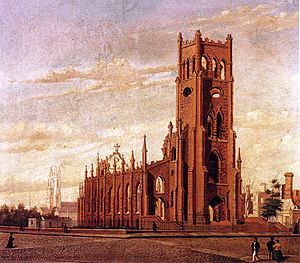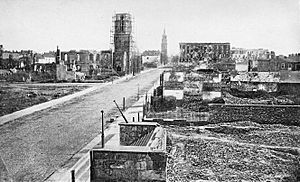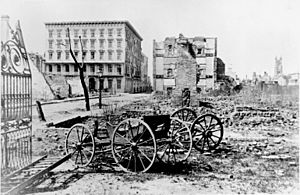Charleston in the American Civil War facts for kids
Charleston, South Carolina, was a very important city for the new Confederate States of America at the start of the American Civil War. It was a key Atlantic Ocean port. The first shots against the United States government happened here. Cadets from The Citadel fired on a ship trying to resupply Fort Sumter.
Three months later, the attack on Fort Sumter officially started the war. The U.S. government called for many soldiers to stop the rebellion. Even though the city was attacked many times by the Union Army and Navy, Charleston did not fall until the war's final months. The city was left in ruins.
Early War Years in Charleston
In 1860, Charleston was the 22nd largest city in the United States. It had about 40,522 people. Coastal cities like Charleston were easy targets for enemy ships. So, the U.S. government built many strong forts along the coast. Fort Sumter was the most famous of these forts. It was built on a sandbar in Charleston harbor.
After Abraham Lincoln was elected president, South Carolina held a special meeting in Charleston. They decided to leave the United States. They felt the new president might try to end slavery. On December 20, 1860, South Carolina became the first state to secede. They explained their decision, saying that the issue of slavery was the main reason.
South Carolina leaders believed the U.S. government was threatening their way of life. They felt that states without slavery were trying to tell them how to run their own affairs. They also worried about slave revolts, as half of the state's population were enslaved people.
After leaving the Union, South Carolina's state soldiers took over Castle Pinckney and the Charleston Arsenal. These places held weapons and supplies. On January 9, 1861, Citadel cadets fired on the ship Star of the West. This ship was bringing supplies to Fort Sumter. Many people in Charleston say these were the first shots of the Civil War.
As the new Confederate States of America formed, they fixed up old forts around Charleston. These forts were aimed at the large U.S. fort, Fort Sumter. Jefferson Davis, the new Confederate president, put General Pierre G. T. Beauregard in charge of the siege. When Lincoln's government said they would send a supply ship with food (but no soldiers or weapons) to Fort Sumter, President Davis ordered the fort to be attacked.
On April 12, at 3:20 AM, after the U.S. soldiers refused to surrender, the Confederates opened fire. Major Robert Anderson, the U.S. commander, knew what this meant. He and General Beauregard knew each other well from their time at West Point. After 34 hours of bombing, Major Anderson surrendered Fort Sumter.
Throughout much of the war, cadets from the Citadel helped the Confederate Army. They trained new soldiers, made ammunition, guarded weapons, and watched over Union prisoners.
On December 11, 1861, a huge fire burned 164 acres of the city. It destroyed many important buildings, including churches, and nearly 600 other structures. Much of this damage was not fixed until the war ended. Some people thought the fire was started by a balloon. Many in the North saw the fire as a punishment for the South leaving the Union.
In June 1862, a small but important battle happened at Secessionville, near James Island, South Carolina. Union forces were pushed back by a smaller Confederate army. This victory was a big boost for the city. It also protected Charleston from a land invasion for a while.
Later War Years in Charleston
Many Southern port cities were blocked by the Union blockade. This made Charleston an important center for blockade running. Ships called "blockade runners" tried to sneak past the Union navy to bring supplies in and out. The Union Navy tried many times to capture Charleston. But the city's defenses held strong for most of the war.
In 1863, the Union started a new attack on Charleston Harbor. They tried a combined attack by sea and land. The naval bombing did not do much damage. The land forces never even got ashore. By the summer of 1863, the Union focused on Battery Wagner on Morris Island. This fort guarded the harbor entrance.
In the First and Second battles of Fort Wagner, Union soldiers suffered heavy losses. They failed to capture the fort. However, a long siege forced the Confederates to leave Fort Wagner by September. An attempt to recapture Fort Sumter by a naval raiding party also failed. But Fort Sumter was slowly destroyed by bombs from shore batteries after Morris Island was captured.
As the Union army got closer to the city, they used newer, longer-range cannons. This meant Charleston was bombed more and more. In November 1863, Jefferson Davis visited the city. He said it was better for the city to be "a heap of ruins" than to surrender. The bombing that started in late 1863 continued for 587 days. It destroyed much of the city that had survived the fire.
In July 1864, the Union launched more attacks on the city. These included an attack on Fort Johnson and an invasion of Johns Island. These attacks failed. But they continued to wear down the city's defenders. The defenders were finally beaten back. The Union captured the city only a month and a half before the war ended.

Charleston Harbor was also where the first successful submarine attack happened. On February 17, 1864, the Confederate submarine H.L. Hunley attacked the USS Housatonic. The Hunley sank the Housatonic. But the submarine itself also sank on its way back. This ended its threat to the Union blockade.
As General Sherman marched through South Carolina, Charleston's situation became very difficult. On February 15, 1865, General P. G. T. Beauregard ordered the remaining Confederate forces to leave. On February 18, the mayor surrendered the city to General Alexander Schimmelfennig. Union troops moved in and took control. The first soldiers to enter the city were members of the 21st Infantry Regiment of the US Colored Troops and the 55th Massachusetts Infantry Regiment. These were Black regiments, and they entered the city singing "John Brown's Body".
Union Celebrations
The recapture of Charleston was a big celebration in the Northern states. The flag that was lowered when Fort Sumter surrendered in 1861 was very important. It had been kept safe and shown at events to raise money for the war. Now, the same officer who lowered it was sent to Charleston to raise it again. Hundreds of people came from far away, even New York, to watch. Famous speakers, like Henry Ward Beecher, gave speeches. William Lloyd Garrison and many reporters were also there. This event is often forgotten because President Lincoln was assassinated that same night, April 14.
U.S. forces stayed in Charleston during the city's rebuilding after the war. General Sherman later wrote that Charleston was punished very badly. But he felt the city deserved it because its people had pushed for war and started the Civil War.






